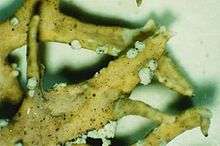Evernia prunastri
| Evernia prunastri | |
|---|---|
| | |
| Scientific classification | |
| Kingdom: | Fungi |
| Division: | Ascomycota |
| Class: | Lecanoromycetes |
| Order: | Lecanorales |
| Family: | Parmeliaceae |
| Genus: | Evernia |
| Species: | E. prunastri |
| Binomial name | |
| Evernia prunastri (L.) Ach. (1810) | |
| Synonyms | |
|
Lichen prunastri L. (1753) | |
Evernia prunastri, also known as oakmoss, is a species of lichen. It can be found in many mountainous temperate forests throughout the Northern Hemisphere, including parts of France, Portugal, Spain, North America, and much of Central Europe. Oakmoss grows primarily on the trunk and branches of oak trees, but is also commonly found on the bark of other deciduous trees and conifers such as fir and pine. The thalli of oakmoss are short (3–4 cm in length) and bushy, and grow together on bark to form large clumps. Oakmoss thallus is flat and strap-like. They are also highly branched, resembling the form of deer antlers. The colour of oakmoss ranges from green to a greenish-white when dry, and dark olive-green to yellow-green when wet. The texture of the thalli are rough when dry and rubbery when wet. It is used extensively in modern perfumery.
Oakmoss is commercially harvested in countries of South-Central Europe and usually exported to the Grasse region of France where its fragrant compounds are extracted as oakmoss absolutes and extracts. These raw materials are often used as perfume fixatives and form the base notes of many fragrances. They are also key components of Fougère and Chypre class perfumes. The lichen has a distinct and complex odor and can be described as woody, sharp and slightly sweet. Oakmoss growing on pines have a pronounced turpentine odor that is valued in certain perfume compositions.
Health and safety information
Oakmoss should be avoided by people with known skin sensitization issues.[1] Its use in perfumes is now highly restricted by International Fragrance Association regulations, and many scents have been reformulated in recent years with other chemicals substituted for oakmoss.[2]
Gallery
| Wikimedia Commons has media related to Evernia prunastri. |
 Close-up photo showing branches with soredia
Close-up photo showing branches with soredia